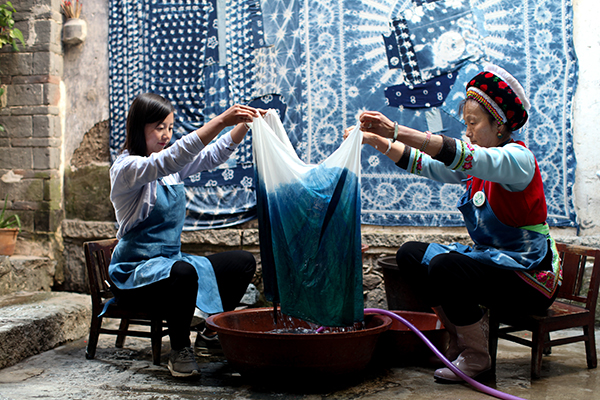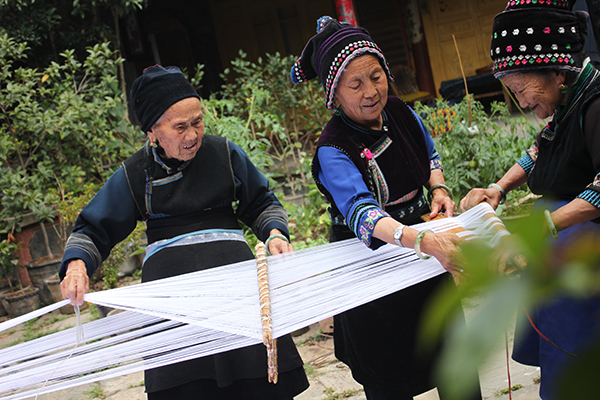
From the People's Daily app.
And this is Story in the Story.
The UNESCO World Heritage site, the Honghe Hani Rice Terraces, in Yunnan Province is known for being aesthetically amazing.
And the autonomous prefecture that hosts the attraction is just one part of the province's tourism upgrade.
Mi'le has invested over $457 million on four towns, to improve infrastructure and livelihoods.
The town has provided preferential policies to attract young artists.
Local craftspeople showcase traditional kite-making and calabash-carving events.
Nearly 740 Axi people, a branch of Yi ethnic group, inhabit Keyi. Modern wall paintings adorn the 370-year-old settlement.
Tourism and e-commerce have lifted them out of poverty.
"Many villagers like me came back to work in tourism," said local tour guide Zhao Jianmei, adding, "we lacked a sense of belonging as migrant workers in big cities. It's good that we can make a decent salary and be with our family."
Today's Story in the Story looks at how the Bai ethnic minority in Yunnan Province is preserving the ancient art of tye-dying and passing it on to younger generations.

Zhang Hanmin (left) and a local woman are tie-dyeing a piece of cloth with a sky blue color extracted from plants. (Photo: China Daily)
In a century-old courtyard, visitors learn how to tie-dye a piece of white cloth.
As tourism takes hold in the Dali Bai autonomous prefecture, in Yunnan Province, more people are seeking such experiences.
The workshop is conducted by the Lanxu Eco-Culture Development Center in Zhoucheng village, inhabited by the Bai ethnic group. It aims to promote the culture of the Bai people and showcase their sustainable lifestyles.
The tie-dyes of the Bai ethnic group use hand-weaved white cloth and colors extracted from plants. Needles and thread are used to make different folds in a cloth and put it into a dye vat several times until the color becomes darker. Common patterns are geometric shapes and flowers. The art form was listed as a national intangible cultural heritage in 2006.
"Tie-dyeing is more than craftsmanship. It's a lifestyle that we want to pass on to others. It's about the harmony between the Bai people and nature," said Zhang Hanmin, 35, who founded the center in 2014.
Zhang, who used to work in a non-governmental organization in Beijing said, "I like doing tie-dye. It's a dialogue with my inner-self and time stands still."
Zhang Hanmin and her husband Zhang Bin are part of the Bai ethnic group from Zhoucheng village who worked in Beijing after they graduated from university.
Hanmin returned to her village to revive the ancient tie-dye technique. Later, Zhang Bin returned to support her work at the center. The couple now live in the village with their 6-year-old son.
Zhoucheng village is famous for the tie-dye skills of the Bai ethnic group, which date back to the end of the Ming Dynasty (1368-1644) and the early part of the Qing Dynasty (1644-1911).
At first, she learned how to tie-dye using plants and draw traditional tie-dye patterns from the local elders.

The elders of the Bai ethnic group in Zhoucheng village, Dali, Yunnan province, are weaving cloth. (Photo: China Daily)
When a 90-year-old craftsman taught her how to extract a blue color from a plant, he worked for more than an hour without drinking water or resting.
"I'm touched by their attitude and love for nature, and it encourages me to persist when I'm faced with difficulties," she said.
The center's reputation is growing among locals and tourists thanks to word of mouth, and the local government also supports them by inviting them to join events in other cities.
Hanmin remembers when she was a child, the local women would dry their half-made tie-dyes on the stone road, and how she would help her mother to tie-dye to get pocket money.
"At that time, my mother tie-dyed with her friends around the stove after supper, and I played with other children. These memories are what drive me to revive tie-dye.”
Hanmin has also started a class to promote Bai culture among local children. As part of the class, she takes them to the mountains to experience the natural beauty of their hometown.
"It's like sowing a seed-who knows which of them will become an inheritor or guardian of our culture in the future. Just like me, how was I to know that my childhood memories would influence me so much," Hanmin said.
When she returned to her hometown for Spring Festival six years ago, she found that few young Bai people were interested in their traditions. "They preferred machine-made clothes, which were cheaper and came with more patterns," she said.
Now, she finds more locals are returning to Zhoucheng to build a career in tie-dyeing.
She now teaches the technique to others in Dali and believes that sharing and communication will boost the industry.
"I want to be an influencer rather than a competitor. It's important that tie-dye shines on the world stage. When we work together to make the market bigger we will make the industry better," she said.
Hanmin combines fashion elements with traditional tie-dye to make products such as scarves and handkerchiefs.
The center currently has 21 employees, many of whom are local Bai youth.
"When young people find that there are such work opportunities that bring a sense of identity, they will be happy to return to make a contribution to their hometown," Hanmin said.
(Produced by Nancy Yan Xu, Lance Crayon, Brian Lowe and Da Hang. Music by: bensound.com. Text from Global Times and China Daily.)


